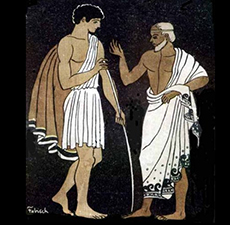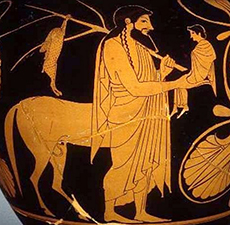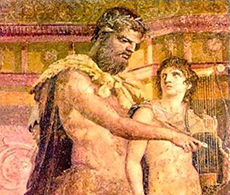The Artistic Meeting: Creating Space for Spirit
When Rudolf Steiner brought together the individuals who would become the teachers of the first Waldorf School, he asked them to work in a new way, not only with the children, but also with one another. He asked them to work together in such as way as to invite the interest and guidance of spiritual beings into their endeavor.
The challenge of creating and maintaining a connection with the spiritual world, as difficult as it was then, may be even more intense in the present time. Materialism has grown considerably stronger in the 21st century, and with it has come an increasing need to bring a balancing, healing, and renewing element to daily life.
The Waldorf classroom is a place where this renewing spiritual element can be found. It arises from the children themselves and from how we work with them. It can also be found in the meeting life of the school, in how the teachers and other adults work together. There are many resources available today on conducting effective meetings in the workplace. This article will focus on how we can create a space for spirit in meetings, and how this endeavor can support us in our individual development, in our encounters with colleagues, and in strengthening our groups and communities.
Meetings as artistic activity will be a second focus. Understanding meetings as an art form and using an artistic approach in planning and carrying out a meeting will more likely allow participants to be refreshed and inspired at the meeting’s conclusion. While including an artistic activity in the agenda can be helpful, it is more critical that the meeting itself be artistic and display the wholeness, drama, and dynamics of any other artistic creation. Artistic activity can often be a doorway to the recognition of spiritual archetypes and the building of spiritual understanding. A meeting that is conducted as a form of art greatly enhances this possibility for the participants.
Meetings as Spiritual Practice
Waking up in the Other
Near the end of his life, after the burning of the first Goetheanum and during a period of upheaval within the Anthroposophical Society, Rudolf Steiner began to speak urgently about the need to build communities based on a shared spiritual purpose that extends beyond our cultural or hereditary ties. He described physical waking as a response to the stimuli of the natural world in our surroundings. Our waking up at a higher level happens when we encounter the soul-spirit of other human beings. He went so far as to say:
We are also unable to understand the spiritual world, no matter how many beautiful ideas we may have garnered from anthroposophy or how much we may have grasped theoretically about such matters as etheric and astral bodies. We begin to develop an understanding for the spiritual world only when we wake up in the encounter with the soul-spiritual in our fellowmen. 1
On other occasions, Steiner also spoke about a need in our age (the 5th Post-Atlantean epoch) that can only be fulfilled in groups. He referred specifically to the spirit of brother/sisterhood hovering above us in the realm of the higher hierarchies, which needs to be consciously cultivated so that it can flow into human souls in the future. These statements constitute a strong call for us to create opportunities for more, rather than fewer, encounters with our colleagues, despite the inevitable challenges with which we are all familiar.
The Reverse Ritual
In considering meetings as spiritual practice, it may be helpful to recall our understanding from anthroposophy that at a certain point in the course of the evolution of the cosmos and humanity, the higher creative beings drew back from the sphere of the earth. This withdrawal was necessary in order for human beings to develop in freedom. As a result, the physical earth is in the process of dying. The human being, having been given freedom and the possibility of spiritual consciousness, has become an increasingly decisive factor in the future of the earth.
One of our tasks is to help re-enliven the earth. We do that with the substance of our human thinking—not our ordinary thoughts and reflections, but spiritual thoughts arising from creative Imaginations, Inspirations, and Intuitions. These creative thoughts represented for Steiner a new spiritual form of communion for humanity. He gave many indications for how both individuals and groups could work with creative, enlivening thoughts for their own benefit and for humanity as a whole.
It was Steiner’s deep conviction that the appropriate form for community-building in our time is what he called the reverse ritual. He distinguished this ritual from a traditional religious ritual in which a mediator is charged with drawing the spiritual hierarchies down to a particular place. “The anthroposophical community seeks to lift up the human souls into supersensible worlds so that they may enter into the company of angels.” 2
“We must do more than talk about spiritual beings; we must look for opportunities nearest at hand to enter their company. The work of an anthroposophical group does not consist in a number of people merely discussing anthroposophical ideas. Its members should feel so linked with one another that human soul wakes up in the encounter with human soul and all are lifted up into the spiritual world, into the company of spiritual beings, though it need not be a question of beholding them. We do not have to see them to have this experience.” 3
The “College Imagination” or the “Teacher’s Imagination” that Steiner gave to the first group of teachers is an example of such a reverse ritual, in which a group working with a common meditative picture creates the possibility of connecting with specific spiritual beings and bringing back creative impulses for their earthly work. 4
If Waldorf teachers wish to work with these ideas and with the example of the “Teacher’s Imagination,” how can we form and conduct faculty and college meetings in this light? How can our meeting life be spiritually sustaining for individuals and build a vital sense of community in our schools?
Space for Spirit
We know what it feels like to have participated in a successful meeting. We are enlivened at the meeting’s end. We also know that what occurred could not have been achieved by any individual member of the group. These are indicators of spirit presence. It is possible to learn how to create such meetings—meetings that lift us out of our ordinary awareness and allow us the possibility of working more consciously with the spiritual world. We can create more space for spirit in our meeting life in the following ways.
I. Imbue the meeting place with a sense of conscious care. It is often the case that certain individuals have a natural feeling for the need to prepare the room where a meeting will occur. When we prepare a space with care we are working with the elementals, spiritual beings which, according to Rudolf Steiner, are detachments from the higher hierarchies, sacrificing themselves for the creation of the material world. They have a great deal to do with the physical setting, and also with our individual physical well-being, our thinking, feeling, and willing, and our communication.
In my own experience, how the room is prepared can have as significant an effect on a meeting as it does on what happens in our classrooms when we make sure that they are clean, orderly, and beautiful. Imagine how the arrangement of the furniture could enhance the quality of the group’s interaction. Consider the effect of having as a centerpiece a seasonal bouquet gathered by a member of the group, rather than one that was purchased at the florist shop. It is especially helpful if all members of a faculty take a turn at preparing the setting, so that more members of the group carry the importance of this aspect of the meeting.
II. Create a threshold mood. Meetings that begin with a moment of silence and a mood of reverence allow participants to be aware of stepping across a kind of threshold, out of our everyday consciousness into a heightened sense of presence. An explicit acknowledgment of our spiritual helpers, the spirit of the school, and those persons who have been connected to our institution and are now in the spiritual world, can also shift the group’s awareness. A conscious effort to begin on time helps create the sense of going through a doorway together. A verse can also represent a threshold and when brought in the right mood, offer a kind of protective sheath for whatever may happen in the meeting.
- Re-establish the sense of the group. This activity has two parts. The first is the recognition of individuals and the second is an affirmation of the purpose of the group. A key to the first part is the interest that we take in one another. Listening to colleagues share something out of their lives or an aspect of their work with students can wake us up to one another in a potent way. The sharing can be brief and, in the case of a large faculty, may involve only a portion of the group each week. Sharing can also be connected to the season; for example at Michaelmas, the focus could be, “What in your life is requiring a fresh burst of courage and will?”
This part of the meeting can deepen our understanding of our colleagues and build the level of trust that we need to work together on spiritual matters. Movement or artistic activity can also serve to strengthen the group’s capacity to work together on issues that require sensitivity to one another. At this stage of the meeting the “I” of each individual is acknowledged as he or she steps into the work with the group, or the “We.”
The second part of establishing the sense of the group is an affirmation of the group’s purpose or task. A verse or reading can be helpful, but must be relevant and alive for the group. For some groups, it may be important to choose a new opening for each year or to work with festival themes in order to strengthen the sense of community and purpose at this stage of the meeting. For other groups, choosing to work consciously with the same verse for many years may actually bring them to an ever-deepening understanding of its meaning and effect. While study is often used to bring a group to a common focus, this is successful only if everyone is actively engaged.
IV. Practice conscious listening and speaking. We know that listening perceptively to another person requires letting go of our sympathies and antipathies and our own preconceived ideas; in fact, we must momentarily let go of our own I to experience the “I” of the other as they speak. Marjorie Spock wrote most poetically about the effects of perceptive listening.
First, there is what it does to the soul of the listener. A miracle of self-overcoming takes place within him whenever he really lends an ear to others. If he is to understand the person speaking, he must draw his attention from his own concerns and make a present of it to a listener; he clears his inner scene like one who for a time gives up his home for others’ use while himself remaining only in the role of servant. Listeners quite literally entertain a speaker’s thought.” Not I, but the Christ in me” is made real in every such act of genuine listening.
Second, there is what happens to the speaker when he is fortunate to be listened to perceptively. Another kind of miracle takes place in him, perhaps best described as a springtime burgeoning. Before his idea was expressed to a listener, it lived in his soul as potential only; it resembles a seed force lying fallow in the winter earth. To be listened to with real interest acts upon this seed like sun and warmth and rain and other cosmic elements that provide growth-impetus; the soul ground in which the idea is embedded comes magically alive. Under such benign influence, thoughts grow full cycle and fulfill their promise. Moreover they confer fertility upon the ground through the simple fact of having lived there. Further ideas will be the more readily received into such a soil and spring more vigorously for its life-attunement. And the soul that harbors them begins to be the creative force in evolution for which it was intended by the gods. 5
Brief spaces of silence can also allow thoughts and insights to ripen and fall into the conversation. Can we provide for the seed thoughts of our colleagues, out of our own souls, what the sun and rain provide for the sprouting plant? It is a rare group that does not need to recommit regularly to practicing this kind of listening and speaking.
V. Work with imaginative pictures over time. Imagination is a language that can bear fruit in the spiritual world. Translating the group’s questions and issues into stories and pictures can enhance the group’s meditative work during the meeting or individual work during the course of the week. Look for an archetype, myth or fairy tale that can reveal new aspects of the matter under consideration. Taking time over two or three meetings to explore major questions invites the possibility of richer insights to come forth. Colleagues will want to hold back from building support for one or another course of action and to be open to new information as it emerges during this phase. Having worked successfully with imaginative pictures in the child study process can help colleagues trust their use in other situations as well.
VI. Share responsibility. Individuals who are able to carry the consciousness for a group have certain capacities that are usually recognized by the other members of the group. Not everyone has these in the same measure, but it is important to recognize talents among colleagues and give one another opportunities and support to develop latent capacities. Different individuals can lead various parts of a meeting. A group of two or three people can plan the agenda. Incorporate means of regular feedback and review for those taking responsibility in the yearly schedule.
It is clear that a group is healthiest when individuals are continuing to grow and develop. Even the most competent facilitator needs to step back or work with a new colleague in order to gain fresh perspective. Rotating leadership and having several individuals carrying one or another aspect of the meeting facilitation makes it more likely that all members will feel involved. All members are responsible to bring to the group the results of their individual meditative life. Spiritual leadership requires learning how to create the conditions for meaningful conversations and then helping the group follow up on what arises out of those conversations.
VII. Let the meeting breathe. In our work in the classroom we need to prepare carefully and also be ready to respond to what comes from our students. A meeting that has a compelling wholeness and feeling of flow is probably the result of a well-crafted agenda along with some adjustments made during the meeting to an emerging sense of clarity and direction. Having prior agreements about how to deal with new information or agenda changes is helpful. A rhythmic relation to time in a meeting creates more of an opening for spiritual insights than either an overstuffed agenda or a formless one.
There are a number of simple possibilities for making a meeting more rhythmic. For example, honor the times on the agenda, but not so rigidly that people feel cut off or topics are truncated. Vary the conversation from full-group sharing to small-group work and individual reports. Create a balance between pedagogical and other topics, looking back and looking ahead, exploring new questions and making decisions. When the group is not moving physically, make sure there is plenty of inner movement. Remember to invite the spirit of Play and the spirit of Humor into the meeting.
VIII. Expect to be surprised. There is nothing more uninviting than a completely predictable meeting. On the other hand, a meeting in which the group is pulled this way and that by personal agendas is equally frustrating. We must stay awake to the influences of Ahriman (too much form) and Lucifer (too much impulse) as they work in individuals and in our groups.
In order to stay the course in the creative spiritual stream, we need to ask real questions; practice positivity and open-mindedness; be comfortable with not knowing; and expect answers and solutions to come from unexpected places.
IX. Review. During meeting review, we give ourselves feedback on what went well and what could have been better, so that we can improve our work together. Review serves another important purpose as well. Just as our nightly review is a conversation starter for the work with our own angel during sleep, our meeting review serves as a seed for the continuing conversation with the spiritual world between meetings.
Running late in a meeting is sometimes the reason that groups neglect review, but review can often capture essential aspects of a meeting in a brief and economical way. In this regard, poetry is more useful than prose. Brief characterizations, even one-word or one-image offerings, can illuminate hidden gems. Hearing individual voices during the review can be a supportive bookend to the work, like the personal sharing at the beginning of a meeting.
Review is not a rehashing of any part of the meeting. It should bring to light aspects of content, processes, and interactions that can benefit from greater awareness on the part of individuals and the group. A perceptive facilitator will vary the means of review and offer questions to elicit information that might not otherwise be brought to light. “Where did we experience gratitude in the meeting?” “Were there any moments of unresolved tension?” “What did we do that might be of interest to our spiritual helpers?” Review in the form of an earnest question is the best kind of invitation to spirit beings.
X. Prepare and follow up. If we recognize our meetings as a kind of ritual, then the preparation and the follow-up are as important as the meeting itself. Preparation requires more than a quick glance at a copy of the agenda. When individuals come to a meeting having thought about the issues and their colleagues the night before, the spiritual ground has already been tilled.
How we carry the questions as well as the tasks from one meeting to the next can make a difference in whether the seeds sowed will sprout healthily in the coming weeks. How each individual carries the group in between meetings will also make a difference. Working rhythmically with time has both a physical and a spiritual aspect. When we consciously release ideas that have arisen in the group into the spiritual world, it is possible that they will return in a more complete or archetypal form.
These are some of the realities that we may wish to take into consideration as we build a vessel for the spiritual aspect of our work, just as we pay attention to earthly realities in constructing a physical home for our schools.
Meetings as Art
The Artistic Process
The arts, according to Rudolf Steiner, were experienced in earlier civilizations as more integral to life than is the case today. Artistic creativity, he said, was experienced as a transcendent spiritual activity, flowing out of the “spirit-attuned state” in which the human being lived in those times. Only since the rise of materialism has the status of art changed from necessity to luxury.
Rudolf Steiner also observed that in our era a longing for the arts comes out of the recognition of the limits of abstract thinking. Ideas alone are not able to illuminate the world in its full richness; they can only point the way to a deeper reality. Artistic feeling, Steiner said, arises when we sense the presence of something mysterious, such as certain secrets of nature, which can only be revealed through our feeling. Knowing is a matter for the heart as well as the head. To discover a whole, living reality, we need to create, to practice art. He saw the fructification of the arts in our time as an important task for anthroposophy, and he took up various artistic projects himself during the latter part of his life.
The present-day artist engaged in the creative process moves back and forth between sense perceptions and intuitive visions—awake, but in a somewhat dreamlike feeling state. Steiner described the subtle changes that occur in a person engaged in aesthetic activity (regardless of whether the person is creating or enjoying an artistic creation) such that the sense organs are re-enlivened and the bodily life processes are lifted to soul-like processes.
In artistic activity we use our heightened sense of feeling rather than our everyday sympathies and antipathies. The artist, consciously or unconsciously, approaches the threshold between the sensible and supersensible worlds and brings something back from the supersensible world into the world of the senses. The resulting creation is a specifically-experienced reality lifted into a universal expression.
As Waldorf teachers we understand the importance of the arts and our own creativity in the work with our students. Can we also imagine applying a consciously artistic approach and a heightened sense of feeling to our work with our colleagues in our meetings?
Social Art
In the series of lectures Art in the Light of Mystery Wisdom, Steiner connected each of the arts with the various members of the human being. The laws of the physical body, he said, are expressed in architecture, the etheric in sculpture, the astral in painting, and the ego in music. The still developing spirit self he connected to poetry and the life spirit to eurythmy. The highest art, according to Steiner, is social art.
The first three arts—architecture, sculpture, and painting (including drawing)—are the spatial arts. These are derived out of formative processes and past evolutionary cycles. They are connected to sculptural forces working out of the past and, in the context of education, help children come into their bodily constitution.
In contrast, the time arts—music, speech and poetry, and eurythmy—are connected to impulses coming out of the future. As Waldorf teachers we work out of our higher bodies and what Steiner called our musical forces in order to guide our students properly into their present life. Social art also belongs to this group of time arts, but is younger, less tangible, and even less developed than eurythmy. How can we study and practice this least tangible of arts?
My own experience is that working in any of the other arts can serve as a basic “instruction manual” for social art. Being grounded in an artistic practice makes it easier to apply the principles of creative activity to any aspect of life, including social situations.
As an early childhood teacher, when I had a particularly satisfying day in the kindergarten, I felt as if the children and I had spent the whole morning moving to an exquisite piece of music. When I was responsible for meetings, I began to plan agendas as if I were composing or painting and, during the meeting, I tried to pay attention to compositional elements like repetition, variation, contrast, harmony, balance, focus, surprise, and reprise.
In addition to the writings of Rudolf Steiner, we can also learn about social art in certain traditional texts where the renewing or healing spiritual element is represented symbolically: the “water of life” from the world of fairy tales, the Grail in the legend of Parsifal, the philosopher’s stone of the alchemists, and conversation in Goethe’s tale, “The Green Snake and the Beautiful Lily.”
In North America we owe a great debt to Marjorie Spock, who brought Steiner’s concern for community-building to us. She translated the Awakening to Community lectures into English and wrote two little pamphlets, titled “Group Moral Artistry,” that are a continuing inspiration for many people. Goethean conversation was the term she used to characterize the process by which a group could invite truth into their midst like a guest. She began with Goethe’s framing of conversation as the art of arts and described Goethean conversation as a form of the reverse ritual and an appropriate means of practicing social artistry.
Artistic Meetings
Our artistic sensibilities and an artistic approach to our work in a meeting can enhance the possibility of lifting ourselves into the company of angels, if only briefly. Meetings can be artistic in a number of ways.
A meeting can be artistic because we consciously include an artistic activity in the agenda and allow what flows out of that activity to enhance the rest of our work together. It can also be artistic in the way we use imaginative pictures to enrich our conversations or moments of silence to invite creative inspirations. When the meeting itself is seen as an artistic process, the facilitator and the group will be more likely to strive for a palpable sense of aliveness and wholeness. Finally, if we take our work in the social art seriously, whatever we are able to achieve in the special situation of our meetings has the potential to strengthen our relationships overall and may even have a healing effect on other relationships in the community.
Conscious Conversation—An Invitation
We swim in a sea of spirit. Our matter-bound everyday consciousness, however, easily forgets the reality of spirit living in and everywhere around us. In this age of Michael especially, we have to wake up in those places where we are sleepily swept along with the materialistic tides of existence. It is not easy to push aside pressing everyday concerns again and again to make space for encounters with spirit in one another and with spirit beings on the other side of the threshold.
As Waldorf teachers, this is a task that we have taken on, not only for the sake of our students, but also because the conversation with the spirit is the source of our own strength, inspiration, and creativity. In our meeting life and through an artistic practice of conscious conversation, we have an incredible opportunity to enter as a group into the realm of spirit-sensing. Our own work as individuals, as well as the whole Waldorf movement, needs this renewing spiritual force as it continues to grow and proliferate in far-flung corners of the world.
Holly Koteen-Soule
Notes
1 Rudolf Steiner, Awakening to Community, p. 97
2 Ibid, p.157
3 Ibid, p.157
4 For a description of the Imagination, see The Foundations of Human Experience, p.45-48
5 Marjorie Spock, Reflections on Community Building, p. 18
Bibliography
Friedrich Benesch and Rudolf Steiner, Reverse Ritual; Anthroposophic Press 2001
Michael Howard, Art as Spiritual Activity; Anthroposophic Press 1998
Marjorie Spock, Group Moral Artistry I, Reflections on Community Building;
St George Publications 1983
Marjorie Spock, Group Moral Artistry II, Goethean Conversation; St George Press 1983
Margreet van den Brink, More Precious than Light; Hawthorn Press 1994
Rudolf Steiner, The Arts and their Mission; Anthroposophic Press 1964
Rudolf Steiner, Art as seen in the Light of Mystery Wisdom; Rudolf Steiner Press 1984
Rudolf Steiner, Awakening to Community; Anthroposophic Press 1974
Heinz Zimmermann, Speaking, Listening, Understanding; Lindisfarne Press 1996










